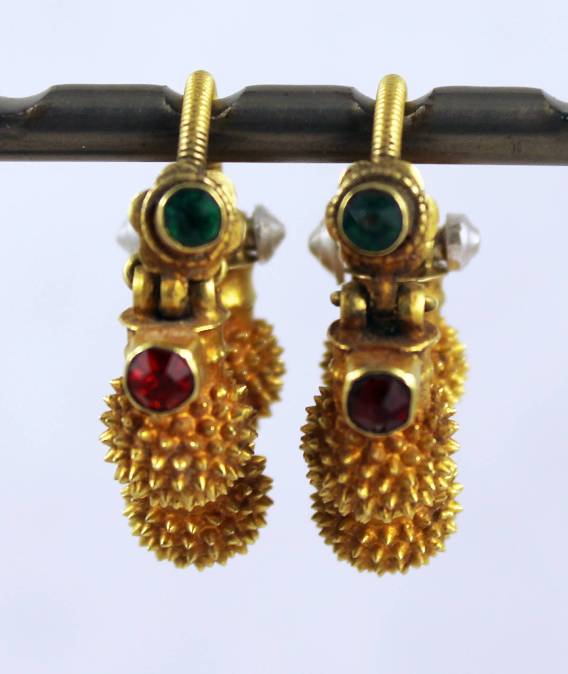Men Ethnic jewelry
In our occidental society we are used to women wearing jewels, but not so much about men wearing them. In any case, men’s jewelry nowadays is discreet!
It has not always been like this. In medieval and modern times men of higher classes wore much more ornaments than now, including pearls, gemstones or, later on, gold and silver applied to utilitarian objects, like watches and buttons.
In other regions of the world men still used a number of ornaments. Some of them are worn to tell us something about the wearer: showing their power; as a way of telling other people about their ethnic origin and social group; to store wealth; to protect themselves with amuletic jewels, and, why not? also for aesthetic purposes.
Picture on the right: Gold and turquoise Tibetan gold earring. The type and shape of this kind of earrings is the same for men and women in Tibet, but women wear the pair and men only one earring.
Meaning of men’s ethnic jewelry: power and social status
Many societies use ornaments as a way to show bravery.
Naga men (India, Burma) used to wear bronze pendants in the shape of heads (one head or more) to indicate the number of men they have taken in war with neighbor tribes.
A similar meaning was attributed in many parts of Africa to feline fangs or ivory, which clearly showed the courage of men killing a lion or an elephant with very primitive weapons. One example is the fangs necklace from the Lega People (DRC).
Ornaments can also show social status. The same Nagas that hung bronze heads on them, use rows of imported glass and shell beads and to show their social status inside the tribe (see picture of a Naga necklace).
Men in Sumatra wear big and heavy belt buckles, which also indicate the position in society of the wearer.
Click on the following pictures to learn more about some men’s ornaments and their significance in different societies.
Ethnic amulets for men
Since prehistoric times, men and women used natural or manufactured items as amulets: shell, gemstones, seeds and later on, bronze silver, and gold amulets.
No so long ago in Catholic countries, men received at Baptism a silver or gold medal, depicting a saint (usually related to the name the baby received).
In different regions of the world, it is still frequent to see men wearing amulets, for prophylactic purposes and to protect the wearer of all misfortunes.
In the Himalayan regions, men take with them a portable shrine that is tied close to the body, like this Tibetan gau.
Some of the amulets shown below are worn by both men and women, like the Indian gold and silver amulets (more info about Indian amulets here), lingam boxes from South India (more info about lingam boxes here) or the Tibetan prayer malas, that hang from the neck or wrists of both men and women.
Here are some amulets worn by men (some also by women). Click on the image to have more information on each.
Men Ethnic jewelry: other meanings
Other intentions are also evident when men wear ethnic jewelry, like the chrematistic value of the ornaments (also the ones made of shell or glass beads, depending on the society and the difficulty to obtain them).
Bubi people, for example, use bracelets and bandoliers made of shells, which are used as money at the same time as being worn. Bracelets from Himachal Pradesh are frequently used as storage of wealth by men and are rarely being worn (because they are heavy too!). Gold in India in all forms (amulets, earrings, etc) is also valued by their weight, and sold in case of need.
Of course, the same ornament can have several purposes at the same time. A gold ornament that shows the social status of the wearer, can also be an amulet, and is valued by the expensive materials employed to manufacture it.
The aesthetics inherent to the ornaments worn by men is also very important! Naga warriors in all their ornaments look proud and brave; Rajasthan men with gold and pearls are very evocative; and African tribal men with ivory and beads appear to be amazing and fearless!
















